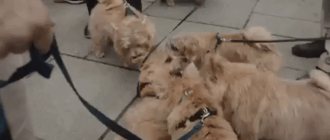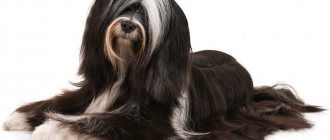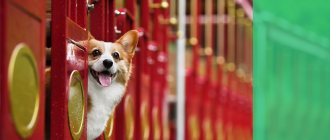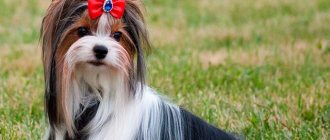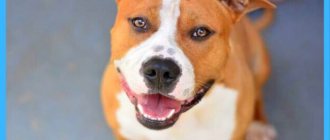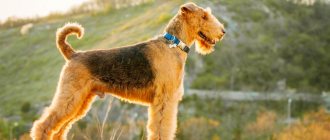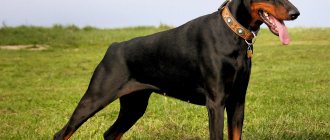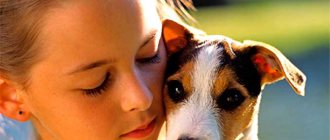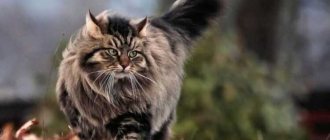Norwich Terriers are the smallest among the variety of hunting breeds. Despite their decorative appearance, they are formidable hunters with a special temperament. Energetic, intelligent, cheerful and friendly dogs seem ideal for apartment living or for a child's first pet. Is it so? Let's look at all the features in this article.
History of the origin of the breed
Norwich dogs were developed in the mid-19th century. The homeland of dogs is the city of Norfolk, and the man who contributed to the appearance of such charming dogs was a hunter seeking to breed a breed capable of hunting and accompanying its owner in unusual conditions in the East of England.
The English county of Norfolk has long been famous for its forests rich in game. The best of each breed of dog was brought to the county from all over Foggy Albion. Therefore, it is not surprising that it was there that a whole “galaxy” of hunting terriers appeared, including the Norwich Terrier, an excellent catcher of small game like rabbits and badgers, who, in addition to his immediate duties, also guarded the owners’ barns from rats.
It is most likely that representatives of the breed were formed by the middle of the 19th century, but it was registered only in 1932. For a long time, two varieties existed in parallel in the breed - with hanging and erect ears, but soon it was decided to separate them. This is how a new breed appeared, named after the county - the Norfolk Terrier, whose peculiarity is the drooping corners of the ears.
For a long time, breeders could not decide on a name for the second variety of the breed, since in different places these dogs were called differently. So, in their homeland, in the city of Norwich, they were called “rethunters” - rat hunters or “regs” - shaggy ones. This name was obtained due to the tousled fur, especially on the face.
The terrier was especially loved among Cambridge students, who considered it their mascot and wanted to give the breed the name of the university. Nevertheless, it was decided to give the breed a name in honor of its hometown and the capital of the county - Norwich.
The Norwich has a visual resemblance to the Yorkshire Terrier, but there is an explanation for this. The ancestor of the Norwich is the black and tan English terrier, which was bred by breeders by crossing a Yorkie and an Irish terrier.
Application
A barn rat catcher or one whose task is to drive foxes out of their holes. These are its original functions, similar to the Wire and Smooth Fox Terriers .
Nowadays, the Norwich Terrier is basically a loyal friend and intelligent companion of a person.
Of course, he is not the one who can sit in his arms while you walk around the city with friends. He needs movement.
Representatives of this breed are very kind to children. The main thing is that the child does not torture the puppy
Description of the breed
According to general ideas about the breed, one can see the features of a typical hunting dog - a small dog with a strong bone skeleton and a moderately wide chest. The type is squat, the body is as massive as possible, which contributes to endurance. By temperament, dogs have a little unpredictability.
According to the standard, Norwich dogs have a distinct characteristic - they do not fool around, but with increased activity, endurance, determination and tirelessness. This breed is one of the smallest representatives of its class, as evidenced by their weight, not exceeding 5.3 kg, and height of 27 cm.
The head is only visually large due to the large accumulation of hair on the muzzle. The shape of the skull is typical for the terrier class: a spacious cranium, rounded towards the top, the frontal part is flat, sharply transitions to the nose, where the muzzle narrows. The muzzle is a third shorter than the skull, but this does not weaken it. The lip is pigmented, thin, and fits tightly to the second.
The teeth are large and appear less proportional when looking at their overall appearance. The incisors are of ideal even shape, the fangs are tightly compressed. A dog with the correct bite, no gaps.
The nose is one of the most sensitive parts of the body. It is black in color, but may have flesh spots and is mobile.
The eyes are of medium width, slightly recessed into the orbital area, which serves as protection for the dog. Eyes with an oval cut, brown color. The eyelids fit tightly to each other. Thanks to its expressive look, the dog seems like an eternal puppy who is interested in everything.
The ears are medium, stand up all the time, have the shape of a triangle, but due to the large amount of hair it seems that the ears are too small. When the dog is concentrated, the ears are tense and move slightly forward; when the animal is calm, they move back.
Strong rectangular body . The neck is short due to its thickness, but this guarantees stability. The scruff or dewlap is not pronounced. The chest is of medium width so as not to interfere with movement. Springy ribs with a noticeable stretch back. The shoulder part is well developed with a sloping croup.
The front legs have less pronounced muscles. The limbs are short, but smooth and thick. Shoulders pulled back, elbows toward sternum with wrists toward the ground. The thighs are of moderate length, but they are quite strong. The stifle and metatarsal joints are at a natural angle, which makes the dog more powerful. The paw pads are strong, as the dog is an excellent digger and also runs quickly.
The tail is short, but thick, adjacent to the dorsal line. It can be natural or cropped. The tail itself is naturally powerful, without rounding, but slight irregularities are acceptable. After docking, it has a straight type that continues the dorsal line.
Colors
The Norwich Terrier has the classic color for terriers. The structure of the fur is hard, wiry, bristling in all directions. The guard hairs lengthen toward the neck area, giving the appearance of a collar. The hair on the face is shorter. Located and clearly visible on the chin and eyebrow area. The undercoat is obligatory and developed.
The following colors are allowed:
- red – bright red, fawn;
- black and red color;
- pinky – creamy red, with a pinkish tint;
- wheat;
- black – the color on the back is darker than on the whole body, reminiscent of a saddle;
- grizzly - an equal combination of red and black;
- tan – black with tan markings on the face, paws, and chest.
The main feature is the absence of white color. No inclusions of this color are allowed by the standard.
Appearance
Self-confident Norwich do not react to aggression. In response to the barking of another dog, he will walk by importantly, throwing his head back proudly.
A terrier with a leadership character is most likely confident that he can defeat anyone, even the most powerful opponent. The strong physique of the dog shows the strength and endurance of the hunter.
Description of the appearance of Norwich Terriers:
- average height is twenty-six centimeters;
- average weight five kilograms;
- elongated deep chest;
- a large head with a sharp transition from a flat forehead to a narrowed nose;
- triangular ears raised up;
- short strong neck;
- dark brown almond-shaped eyes;
- small black nose;
- teeth are sharp and even;
- strong muscular paws with sharp claws;
- the tail is most often docked at two-thirds, but natural length is allowed;
- The wool is hard and thick. There are different colors: black and tan, wheaten, red.
Character and behavioral characteristics
Norwiches are smart and proud dogs who love their owners passionately. Excellent companions, they are friendly and active. They differ from many breeds in their calm attitude towards loneliness - they do not whine or “cry” in the absence of people, and do not damage furniture and shoes. They are easy to train and love agility and other dog activities.
A hunting dog has the habits and habits of the breed. Norwich are susceptible to the influence of natural instincts, which is manifested in the following features:
- They cannot walk without a leash. One of those breeds that requires special training, since their tendency to search and pursue prey does not allow them to be allowed to go for independent walks;
- Dangerous neighbors. Representatives of this breed, in principle, do not get along well with other pets: Norwich dogs are aggressive towards rodents and cats, as they were bred specifically for hunting animals of this size;
- Impatient with children's aggression. Many owners talk about how their pets steadfastly endure the mischief of children who pull their dogs’ noses and tails. The terrier cannot be called a fan of such games, and he can fight back. The child must immediately be explained that the terrier is not a toy.
Breed character
The dog is cheerful and good-natured, which is not always typical for small dogs. They are usually nervous and even aggressive. However, hunting dogs, even small ones, usually have strong nerves and a cheerful mood.
Norwich Terriers are distinguished by their special devotion to their owner, which is not always typical for dogs with a passionate hunter's character. However, over the years of life as a companion, not knowing what game is even in the form of a rat, this dog has lost its hunting drive, but has not lost its charm and unusual charm.
These dogs are very active. They don't just need to run around, bark and discover new things all the time. They need long walks in places where they can poke their nose everywhere, bark, chase or look for someone. These are little gambling adventurers.
The temperament of these hunters is usually described with a hint of some uncontrollability. In the description of the character standard, a special line highlights such characteristics as active, hardy, purposeful, tireless. However, among these characteristics there is not a word about foolishness, disobedience and hooligan habits.
The dog is cheerful and good-natured, which is not always typical for small dogs
So, before you get this charming little creature, think about whether you can provide him with proper living conditions. And the main thing is whether you yourself can withstand this pace of life.
From this description one may get the impression that this dog is difficult to control and its cheerful disposition can result in nervous exhaustion and headaches for the owner. Nothing like this. This dog is obedient and knows the limits of pranks.
Education and training
Training is practically no different from that which is carried out with other representatives of terriers. Some breeders are practically unable to cope with the character of the Norwich, so they resort to the help of dog handlers. Difficulties begin at the first stage of basic training. Carried away by the area, the Norwich Terrier may ignore the owner’s commands, as he is often lost or completely lacks attention.
Even in old age, activity and endurance are maintained, the dog remains energetic, with increased mobility. To keep fit, it is recommended to exercise your dog regularly.
- The recommended duration of training is no more than an hour, regularity is once every two to three days.
- The Norwich Terrier loves to play. Therefore, for a walk you need to take a tug-of-war rope and other toys of this type. There is no effect from the dog playing in the apartment. Therefore, the owner must provide the pet with activity.
- There is no need to be surprised that during the game the dog can play too much and become aggressive. They love to remain the winner in any competition.
- Physical punishment is the worst way to get what you need to know.
- If the dog needs to be punished for bad behavior, the owner must use the tactic of ignoring - immediately after the offense, reprimand the animal in a stern voice and not notice it for several hours.
- The best method is encouragement.
Each animal is individual. Dogs have different personalities, and how you train an animal at the age of a puppy is how it will behave in the future.
Terriers are not dogs for street keeping; cold and constant loneliness will have a bad effect on health and behavior. The terrier can be kept both in the house and in the apartment, since it does not shed, its coat is odorless, it tends to be clean, it is calm, and with proper training it never damages furniture. Unlike many small breeds, the Norwich Terrier is not capricious and does not require constant attention.
Attitude towards children and others
People who have small children can safely get a playful, kind dog. Dogs will become for them not only gambling partners for active games, but also reliable defenders and guards. Despite its small size, Norwich will not allow anyone to offend him, much less a child for whom he feels special responsibility. Among the distinctive features of the little brave man are devotion and the ability to self-sacrifice.
Norwiches are friendly towards strangers, but only until they feel aggression from them or a threat to the owner.
These terriers prefer to play with their relatives rather than fight. Therefore, they will not mind living in the same house with dogs or cats. But small pets (hamsters, rabbits, guinea pigs and others) are perceived by a hunting dog as prey. It is extremely difficult for an animal to overcome a genetically instilled instinct; even with a special course of training it is not always possible to suppress it.
Diseases
The breed was bred for hunting, so the Norwich Terrier at puppy age is quite hardy and rarely susceptible to disease. But the most common diseases in these dogs are:
- epileptic syndromes;
- tracheal collapse;
- brachycephalic disease (soft palate lengthens);
- allergy to certain cereals.
- pancreatitis;
A dog may have rabies, plague, or infectious hepatitis. But only timely vaccination can save you from this.
The average life expectancy of terriers is twelve to sixteen years.
Terrier puppies are born with large heads, so females need veterinary care.
Many terriers have problems with the spine; the best prevention is proper nutrition and exercise.
Health and life expectancy
The lifespan of Norwich Terriers is 13-15 years, which is average among the various terrier breeds. Common diseases are:
- cataracts, glaucoma, other eye diseases;
- deafness;
- scabies;
- allergic reactions;
- epilepsy;
- hip joint diseases.
In general, Norwich cats are in good health, and it is recommended to have a routine check-up with a veterinarian every year to prevent disease.
Care
Norwich Terrier dogs do not require complex care. The coat is combed once a week. Like many wire-haired breeds, they do not shed seasonally, that is, old dead hairs do not fall off, but remain in place in the form of a dense “shell.”
Haircut, trimming and bathing
Grooming, trimming or plucking dead hairs on your dog will help keep the coat clean and well-groomed. Thanks to this procedure, the room is cleared of animal hair. Trimming prevents blocking of skin pores, which occurs when new hair grows, but existing hair that has died is in the way. With careful plucking, the quality of the animal's fur is preserved.
The procedure must be carried out at least a couple of times a year; for this, you can contact professional groomers or carry out the procedure yourself. This requires special knowledge, since inexperienced work can ruin the appearance of the animal.
Theoretically, there is nothing complicated, but you need to understand which hairs should be plucked. Therefore, it is recommended to carry out the first procedure of plucking dog hair with a knowledgeable person. This will get rid of troubles for the dog.
Due to its size, the Norwich Terrier does not get very dirty at home, and its coat does not get tangled, which allows it to be washed whenever it gets dirty.
Bathing should not be done frequently; it is advisable to wash it whenever it gets dirty. Dogs need weekly eye and ear examinations and cleanings.
It is unacceptable to use shampoos not intended for dogs. This can negatively affect the quality of the wool.
After walks, it is necessary to check for ticks, and also periodically treat the animal for helminths.
Feeding
The Norwich Terrier loves to eat a lot, so no matter how much he puts on his plate, he will eat it all. Owners should control portions for their pet.
The diet is selected to be balanced with all the main components: proteins, fats, carbohydrates. The obligatory presence of buckwheat, rice, fermented milk products, dietary meat, eggs, cottage cheese, cereals, vegetables and some fruits.
You can add vitamin supplements as complementary foods, which your veterinarian will recommend. It is strictly contraindicated to feed chocolate, bird bones, fatty meats, and spices.
Among artificial foods, the most suitable for Norwich are specialized mixtures for small wire-haired breeds of the highest quality. Low-quality ones lead to diseases of the gastrointestinal tract, problems with teeth and gums, and hair loss.
At a young age, ingredients rich in vitamins should be supplied. If there is a lack of any microelements, the development and growth of the baby is suspended. Upon arrival to the new owner, it is recommended to give soaked dry food, so it is gradually transferred to natural food. If you immediately feed natural food, the puppy will suffer from an upset stomach.
It is advisable to feed before the family sits down to the table, so that a well-fed animal does not beg for handouts from the table.
Nutrition
Each owner decides to feed the dog natural products or special food. Veterinarians advise giving preference to the second method. Since the manufacturers have done a good job on the composition of the feed.
They made the food balanced and filled it with essential vitamins, calories and minerals. In addition, the food is already prepared food, which means there is no need to waste time preparing food for the Norwich Terrier. This saves a lot of time.
But if the owner feeds his pet with natural products, then he must carefully monitor not only the freshness and quality of the products, but also the amount of nutrients, vitamins, and minerals that enter the dog’s diet. The daily menu for the Norwich Terrier contains:
- Lean meats. It is advisable to boil it. But pork should not be given in any form, as it is too heavy food for the Norwich's stomach.
- Fruits.
- Vegetables.
- Buckwheat and rice. Other cereals can also be given, but these are the ones that will have the maximum effect.
- Low-fat cottage cheese, kefir and other fermented milk products.
- Vitamin complex.
Norwich Terrier owners should know that they should not give milk, potatoes, baked goods, flour products, bones, or sweets to their pets. Since the dog’s stomach has difficulty digesting foods that are not intended for it.
In order for your dog to live many years and remain in good health, you need to feed it correctly. To do this, you can consult with professional breeders who can accurately create a diet for the Norwich Terrier. Kennel or private home does not matter where the dog lives. You need to follow her correct diet anywhere.
How to choose a puppy
What shape the tail has, whether the ears are erect, whether the body is proportional - this is what the owner should pay attention to when choosing a puppy of this breed in the kennel. This is especially true for show animals.
Before assessing the baby, attention is paid to the mother and father, or one of them.
By all standards, the puppy should already be accepted, right down to the coat color. A roundish skull that widens towards the ears. A clear boundary of the transition from the forehead to the nose. The muzzle appears short when compared to the skull. A child with a scissor bite – the upper row of teeth overlaps the lower one. The teeth are almost perfectly straight, but do not protrude, being perpendicular to the jaw. The ears are always erect and have a clear triangle shape. Due to the fact that the neck is thick, it appears short.
The tail is straight; if the dog goes to a show, it is not docked. The limb thickens towards the base, tapering at the end. The paws are similar to those of a cat, but shorter and thicker.
If the paws are tilted at any angle, this indicates that the breed is damaged.
The hairs of the coat are hard and have a thick undercoat. The fur in the neck area is lengthened, giving the appearance of a muff. The baby can have the following colors: fawn, black and tan (black and tan), zone, as well as any of the shades of orange. If there are white inclusions, this indicates a deviation from the FCI standard. Looks like its parents at 3-4 months.
Tips for choosing a puppy
Choosing a Norwich baby is not an easy task. In this matter, it is important to pay attention to the following parameters:
- The appearance must correspond to the standard: wedge-shaped muzzle, clearly visible stop, correct teeth bite, erect ears. The baby should be moderately well-fed, the eyes should be clear, the coat should be thick and shiny, the palate should be pink, and the area under the tail should be dry and clean.
- The baby is taken away from the mother dog no earlier than 3 months of age, when all the basic rules of behavior and socialization have been instilled.
- Behavioral characteristics - a Norwich Terrier puppy should be sociable, inquisitive, active, and immediately make contact.
- You should get acquainted with the pedigree, awards and achievements of the puppy’s parents. Even better is to ask the breeder for a health certificate.
When choosing a Norwich, pay no less attention to his gender. Bitches are calmer and good-natured, males are wayward, disobedient, and always strive for leadership.
Price and where to buy a puppy
Norwich Terriers are a new breed for the CIS and Russia, so you can only buy them in a few specialized nurseries. When buying a puppy, you should very carefully examine the puppy, its parents, pedigree and documents of the dog. The cost of a puppy depends on external characteristics and gender:
- pet class - up to thirty-five thousand rubles;
- breed class - up to fifty thousand;
- show class - from fifty thousand rubles.
The owners of the Norwich breed speak purely positively about it, most often noting such qualities as intelligence, friendliness, trainability and ease of maintenance.
Norwich Terrier price
The cost of a pet is determined by its age and gender. Young dogs are more expensive than adult dogs, and males are often cheaper than females. Breeders are slightly inferior in price if there are noticeable discrepancies in the appearance of the Norwich Terrier with the breed standard. On average, the cost of a brave rat catcher reaches 35,000 - 50,000 rubles (depending on the characteristics of the animal). Those coming from bird markets and pet stores are much cheaper, but at the same time there is a high risk of acquiring a watchdog of an unknown breed. In the case of the Norwich Terrier, this is unacceptable: every dog breeder should get to know the remarkable charm of the brave little one!
Briefly about the main thing
- The Cambridge Terrier is an excellent dog, suitable for an experienced dog breeder, since even friendliness cannot hide the true purpose of the breed - to hunt rodents.
- Good training will be required, starting at the age of six months. Otherwise the animal will be disobedient.
- Norwich is great for busy people, as they won't get too bored when they're alone.
- This breed does not require special care; just brushing once a week is enough.
- The dog is active, and therefore will require sufficient physical activity from the owner.
- Terriers love to eat often, so your pet's diet will have to be monitored all the time, otherwise health problems may arise.
- Norwich dogs should be developed through games of being a little hunter.
- When choosing a puppy, pay attention to the tail, ears and body proportions.
- A puppy with a pedigree can be bought from 30 thousand rubles.
Pros and cons of the breed
The decision to have a pet in the form of a Norwich Terrier is not enough; you still need to sensibly weigh your options. Representatives of the breed are extremely active and mobile, the owner must match this pace of life.
The Norwich Terrier is a rather rare and expensive dog. Check out its main pros and cons.
Advantages:
1. Intelligence and intelligence. 2. Suitable for apartment maintenance. 3. Can handle loneliness without problems. 4. Doesn't bark for no reason. 5. Gets along with children. 6. Has no habit of starting fights with other dogs. 7. Loyalty, friendliness, playfulness.
